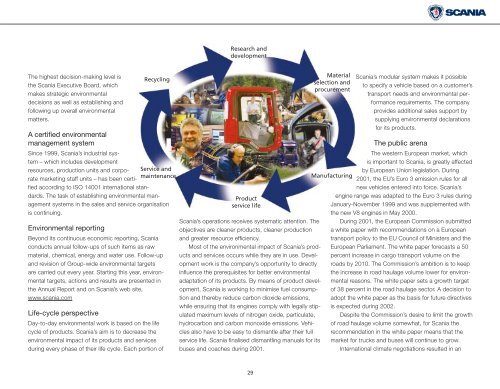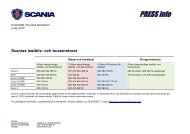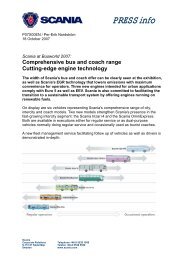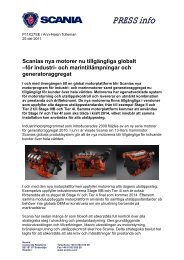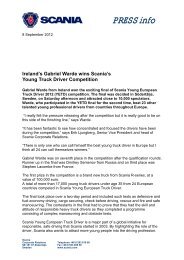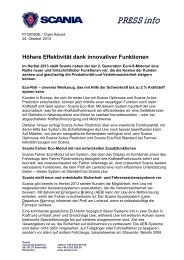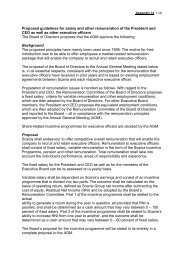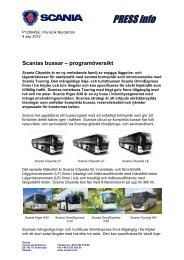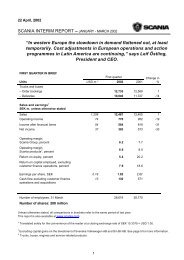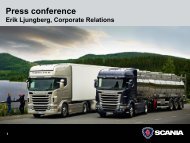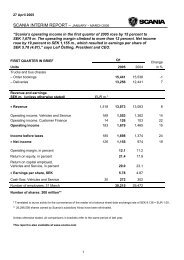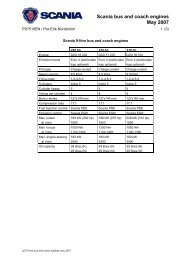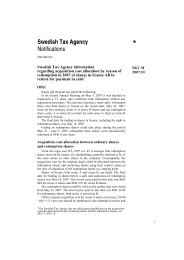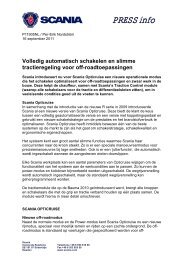Scania annual report 2001
Scania annual report 2001
Scania annual report 2001
You also want an ePaper? Increase the reach of your titles
YUMPU automatically turns print PDFs into web optimized ePapers that Google loves.
Research and<br />
development<br />
The highest decision-making level is<br />
the <strong>Scania</strong> Executive Board, which<br />
makes strategic environmental<br />
decisions as well as establishing and<br />
following up overall environmental<br />
matters.<br />
Recycling<br />
A certified environmental<br />
management system<br />
Since 1999, <strong>Scania</strong>’s industrial system<br />
– which includes development<br />
resources, production units and corporate<br />
marketing staff units – has been certi-<br />
Service and<br />
maintenance<br />
fied according to ISO 14001 international standards.<br />
The task of establishing environmental management<br />
systems in the sales and service organisation<br />
is continuing.<br />
Environmental <strong>report</strong>ing<br />
Beyond its continuous economic <strong>report</strong>ing, <strong>Scania</strong><br />
conducts <strong>annual</strong> follow-ups of such items as raw<br />
material, chemical, energy and water use. Follow-up<br />
and revision of Group-wide environmental targets<br />
are carried out every year. Starting this year, environmental<br />
targets, actions and results are presented in<br />
the Annual Report and on <strong>Scania</strong>’s web site,<br />
www.scania.com<br />
Life-cycle perspective<br />
Day-to-day environmental work is based on the life<br />
cycle of products. <strong>Scania</strong>’s aim is to decrease the<br />
environmental impact of its products and services<br />
during every phase of their life cycle. Each portion of<br />
Product<br />
service life<br />
<strong>Scania</strong>’s operations receives systematic attention. The<br />
objectives are cleaner products, cleaner production<br />
and greater resource efficiency.<br />
Most of the environmental impact of <strong>Scania</strong>’s products<br />
and services occurs while they are in use. Development<br />
work is the company’s opportunity to directly<br />
influence the prerequisites for better environmental<br />
adaptation of its products. By means of product development,<br />
<strong>Scania</strong> is working to minimise fuel consumption<br />
and thereby reduce carbon dioxide emissions,<br />
while ensuring that its engines comply with legally stipulated<br />
maximum levels of nitrogen oxide, particulate,<br />
hydrocarbon and carbon monoxide emissions. Vehicles<br />
also have to be easy to dismantle after their full<br />
service life. <strong>Scania</strong> finalised dismantling manuals for its<br />
buses and coaches during <strong>2001</strong>.<br />
Material<br />
selection and<br />
procurement<br />
<strong>Scania</strong>’s modular system makes it possible<br />
to specify a vehicle based on a customer’s<br />
transport needs and environmental performance<br />
requirements. The company<br />
provides additional sales support by<br />
supplying environmental declarations<br />
for its products.<br />
The public arena<br />
The western European market, which<br />
is important to <strong>Scania</strong>, is greatly affected<br />
by European Union legislation. During<br />
Manufacturing<br />
<strong>2001</strong>, the EU’s Euro 3 emission rules for all<br />
new vehicles entered into force. <strong>Scania</strong>’s<br />
engine range was adapted to the Euro 3 rules during<br />
January-November 1999 and was supplemented with<br />
the new V8 engines in May 2000.<br />
During <strong>2001</strong>, the European Commission submitted<br />
a white paper with recommendations on a European<br />
transport policy to the EU Council of Ministers and the<br />
European Parliament. The white paper forecasts a 50<br />
percent increase in cargo transport volume on the<br />
roads by 2010. The Commission’s ambition is to keep<br />
the increase in road haulage volume lower for environmental<br />
reasons. The white paper sets a growth target<br />
of 38 percent in the road haulage sector. A decision to<br />
adopt the white paper as the basis for future directives<br />
is expected during 2002.<br />
Despite the Commission’s desire to limit the growth<br />
of road haulage volume somewhat, for <strong>Scania</strong> the<br />
recommendation in the white paper means that the<br />
market for trucks and buses will continue to grow.<br />
International climate negotiations resulted in an<br />
29


